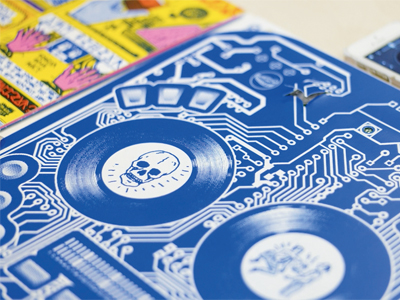Sabine Geldermann, director of drupa
The effects of the internet and the upsurge in interest in 3D printing, printed electronics and mobile applications, is taking the concept of communication into a new space. Printers need to embrace these developments, face the challenges and use their creativity. The future of print can be grasped with both hands at drupa 2016.
The successful printer of the future will deliver customers a full service offering that extends well beyond printing and finishing. The exact mix of digital communications, value added print, data manipulation and logistics will depend on the customer base and how the printer positions himself, or perhaps how he forms partnerships with others with expertise in these areas. But what is going to make print a successful communications medium in the next decade is already clear: print has to be relevant.
This was not necessary when print was the prime channel for advertising, information, communication with government and so on. Much of this mundane printing has transferred to digital and will never come back, but print is not shrinking. It is evolving into something smarter, more versatile and above all more relevant to those who receive it.
If a printer is not part of this development, the only option is to sell print services as cheaply as possible and this is no way to build for the future nor to create enduring partnerships with customers.
IT drives print relevance
Tomorrow’s printer must become as comfortable with IT as he is with offset litho. That can stretch from operating a website to harvest jobs, to creating automated workflows that minimise touch points where errors can be introduced, using MIS to record and present up to the minute details of how a company is performing, through to data handling to create personalised communications for customers to talk to their customers in the most relevant way. If that means using social media alongside print, the new print house has to deliver.

Novalia’s printed electronics brings print to life
The problem here is that printers continue to prefer to invest in a new printing press rather than in IT. It is as if the press is tangible and understandable. If it runs at 18,000 sheets per hour (and machines at drupa 2016 are likely to hit 20,000 sheets per hour) this is 20-30% faster than their current machine, so must make sense. But few give due thought to how jobs are to be processed either before reaching the press, or once printed. Across the globe, print runs are falling and time allotted is shrinking. A faster press magnifies the problem of handling more jobs in less time without introducing errors. In addition, too few consider training for their staff to be an investment rather than an imposition.
The first drupa ‘Global Insights Report’ published in October 2014 highlighted this: ‘Only 23% of the drupa expert panel report an increase in IT spend in the last five years, and virtually all decision makers stated a lack of IT specialists. This is a major challenge for printers,’ said Sabine Geldermann, director of drupa 2016.
IT knowledge is key for automation at the process level. Those supplying software to the industry take it as read that JDF compliance is essential. Workflows have to become more sophisticated. Producing an eight page section on standard paper is simple, but tomorrow’s customers will want something far more than this. They will want their printed products to stand out, to have the impact to cut through the thousands of marketing messages that are received each day.
drupa president and chief executive officer of KBA Claus Bolza-Schünemann predicts that ‘in some years from now there will be fewer printing companies but they will be larger and more industrial with a broad service range; in the commercial sector printers will turn into marketing service providers for print and online services’.
He added that the connection between print, online and mobile activities will grow stronger.
The transition is in its infancy. A well-known commentator on advertising and the internet pointed out last year that consumers spend vast amounts of time with their smartphones, but these only take a small proportion of the overall marketing spend, whereas the fast shrinking newspaper sector receives a disproportionate amount of advertising spend. One must shrink its share while the other one grows – unless the newspaper becomes more relevant to its reader. This means hyper local sections, printed digitally with targeted advertising.
Revalidating print in a digital world
The same can be noticed in magazines, where the mass circulation titles that used to be printed gravure are losing circulation while magazines that focus on the special interests of readers remain healthier. The magazines that focus on this sort of reader will not be displaced by digital delivery of content because reading a magazine is so much more than the information presented.
A decade ago it was predicted that with the growth of the internet, video on demand and the ability to interact with websites, fashion magazines must disappear because websites can show clothes being worn, have links to prices and instant ordering. But fashion magazines are stronger than ever because possession of Vogue makes a statement about the women carrying it. Online fashion websites like ASOS and Pret-a-porter have launched printed magazines because of this phenomenon.
The doomsayers who predicted the same fate for catalogues have also been thwarted by human nature. We like to browse a catalogue or holiday brochure. They spark our imagination in a way that digital fails to do. And retailers that either exist only online or else which dropped their print catalogues are returning to print to remind customers to visit their websites to complete a purchase. If online shopping is going to grow, more and more print is going to be needed.
But it is not going to be the same sort of print as of old. Why send someone who always takes a vacation in Mexico details of holidays in Canada for example? Instead the holiday company, with the help of the printer, can tailor a brochure that features the best hotels and resorts in Mexico. It will be a smaller publication with a shorter production run, but production standards can be higher in terms of print, paper and personalisation.
The printer must be ready to deliver this to his customers.It means investment in technology that can cope with shorter print runs. It means the ability to print on uncoated papers which are popular because of their tactile qualities, and this can be addressed through the new UV technologies that are spreading through the industry. It means being able to enhance the printed product using varnish, foils, raised print effects, die cutting and other processes that enhance the value of the printed product and make it more exciting and engaging to the consumer.
This can involve the inclusion of printed electronic circuitry to turn a printed page in a book or magazine into a loudspeaker to tell a story; the dashboard of a car which comes alive when various buttons and switches are activated; a printed label which can light up when a sensor detects movement.
Embedded codes within the printed page are scannable by smartphones to unlock digital information for the consumer, perhaps an offer to be redeemed in a certain store or restaurant, while providing the company making the offer with information about who has scanned the code, where and when. The printed poster or advertisement acquires a measurable value because it proved to be relevant to that consumer at that time.
Increasing the value
Printers should focus on benefits such as personal service, same day printing, wide choice of substrates, design, fulfilment and so on. Even this requires marketing skills that need to be developed.

Scodix enhanced print samples
The answer will be different depending on the printing company says Claus Bolza-Schünemann: ‘Every printing house knows its customers and its strengths best. Therefore, it is of little help to simply copy the recipe for success of others. If every company offered the same this would automatically lead to over-abundance in the market with the familiar consequences.’
Alon Bar-Shany, vice president and general manager of HP Indigo, agrees: ‘There is pressure to commoditise, options for lower quality and lower pricing, but that would spell disaster for the industry. The opportunity is for less pages but higher value ones. Printers need first to acknowledge change and then embrace it. The industry needs to evangelise the inherent beauty and effectiveness of print in a digital world.’
Printing will remain at the heart of it, but printers must become like project managers, shepherding the different aspects of the communication chain to achieve the result that the customers want, reaching a measurable return on investment. The focus on reducing overheads in the end to end supply chain has already transformed how books are printed and distributed; digital printing is starting to eat into packaging for the same reason. Printers need to expand their thinking beyond the creation of the box.
For those companies that can do this, that become engaged with their customers and work together to find solutions that embrace print at some level, the future is bright. Print is no longer the dumb sheet of paper that is recycled in moments. The smart printers are discovering this. Value now is a function not of scarcity but of relevance.





